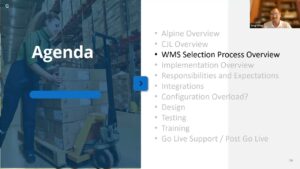When transportation and logistics leader First Logistics’ growth took off, so did their need for a more robust Warehouse Management System (WMS). Their homegrown Inventory Control System wasn’t built to handle their increasing order volumes and system limitations were hampering associate productivity and impeding a sustainable Flow-of-Goods operating model. Plus, the homegrown system was dependent on outsourced partners, which introduced a high level of risk. First Logistics wanted to ensure they invested in the right WMS for their business, so the supply chain leadership team decided to embark on Best Practice Assessment (BPA) to gain a better understanding of their requirements and build a solid case to cost to justify their investment. They engaged Alpine Supply Chain Solutions to lead the exercise.
According to Alpine’s Managing Principal, Michael Wohlwend, “A BPA is a great exercise to help organizations uncover opportunities for improvement while benchmarking their operations against competitive, best-in-class operations. They take just a few weeks and are a great fit for companies seeking to identify supply chain improvements, define requirements, estimate costs, and quantify ROI.”
How does a Best Practice Assessment work?
A BPA will vary by client and objective, but a standard engagement ensures that all business processes and areas of operation are fully reviewed and assessed. By diving deep into the details, a BPA can uncover capital and non-capital improvements across all operational areas including inventory, space, equipment, labor, and systems.
A standard engagement is a four-week process and will look as follows:
Week 1: Data Collection
Our data-driven methodology leverages a deep dive into metrics in every area of your operations including procurement and receiving; putaway; restocking and replenishment; order processing and selection; shipping, staging, loading, VAS; and more.
Week 2: Data Validation
We validate initial data findings during an onsite visit and cross-reference our findings against Best Practice metrics from market leaders such as WERC, ROFDA, and ISO.
Week 3: Qualification
We share initial findings to prioritize the initiatives that streamline business processes to increase operational performance, improve customer service, and reduce cost.
Week 4: Final Results
We create and deliver a plan of actionable improvement recommendations and associated ROI.
What’s the value of a Best Practice Assessment?
The value of a BPA varies by the initial objective of the exercise. For First Logistics, a BPA enabled the supply chain leadership team to confidently respond when Executive Leadership questioned what a WMS would cost, how long an implementation would take, and when they could expect to see benefits. The project was approved as was the cost to add additional resources to implement the WMS as the team was able to clearly identify what resources were available and where there were gaps.
Why the time is right for a Best Practice Assessment
Over the past few years, supply chain leaders have faced more complex, changing conditions than ever before. Enterprises of all shapes and sizes are seeking to shake up their supply chain strategies to become more resilient, collaborative, and networked with customers, suppliers, and other stakeholders. A BPA offers a great method for understanding which supply chain Best Practices will significantly improve product quality, customer service levels, market share, and return on assets, and as a result, your company’s overall performance. Reach out if you’re interested in learning more.













